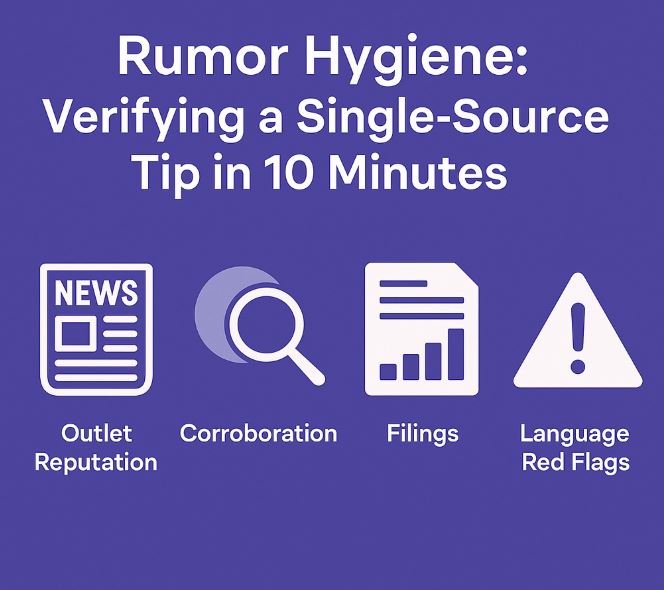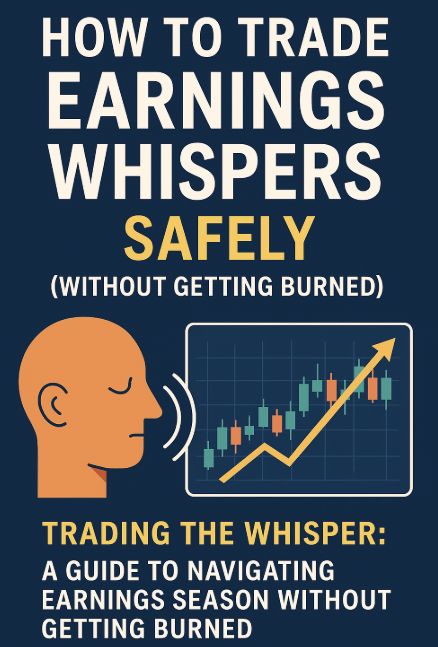
In the world of trading, rumors hit fast, spread faster, and can move billions before official confirmation ever arrives. But not all whispers are worth your capital. The difference between chasing noise and seizing opportunity comes down to one skill: rapid verification.
This is your 10-minute workflow for pressure-testing a single-source rumor. The goal isn’t to prove it true or false—it’s to decide whether it deserves space on your watchlist or belongs in the trash.
Step 1: Assess the Source & Outlet (3 Minutes)
A rumor is only as strong as the outlet and author behind it.
- Outlet Reputation: Start with the platform itself. Reuters, Bloomberg, The Wall Street Journal, or AP? Those sit at the top of the trust ladder. An anonymous Substack or a hype-driven X account? Far weaker.
- Quick check: Search “[Outlet Name] bias” or “fact-check” and skim ratings from AllSides or Ad Fontes Media.
- Author’s Track Record: Credibility narrows to the individual journalist or poster. A seasoned M&A reporter breaking a deal scoop carries weight. A brand-new account with no history? Red flag.
- Action: Click the byline or profile. Scan their last few stories and beat coverage.
Step 2: Hunt for Corroboration (4 Minutes)
Legitimate scoops rarely stay single-sourced for long.
- Scan Major Outlets: Search the rumor’s keywords on Google News, filtering to the last 24 hours. If the tip is real, competitors will be scrambling to confirm. Silence can signal trouble.
- Check Official Sources: Public companies and agencies leave paper trails.
- SEC’s EDGAR database → filings like 8-Ks or 13Ds
- Company IR pages → press releases
- Agency sites (FDA, DOJ, FTC, etc.) → announcements
If the rumor is material, there’s usually a breadcrumb somewhere.
Step 3: Analyze the Language (2 Minutes)
How a rumor is written often screams its reliability.
- Vague Weasel Words: “It is rumored that,” “sources say,” “an insider claims.” If it’s coming from Reuters, maybe. If it’s a thin blog post? Big warning sign.
- Emotional or Sensational Tone: Words like explosive, shocking, or secret plot belong in clickbait, not professional reporting.
- Concrete vs. Cloudy: “Tech giant in talks for an acquisition” is fog. “Company A in late-stage talks to acquire Company B for $50B” is at least testable.
Step 4: Synthesize & Conclude (1 Minute)
At the 10-minute mark, force a judgment:
- High Confidence (Likely True): Trusted outlet, credible journalist, corroboration, maybe even a filing.
- Moderate Confidence (Plausible): One strong outlet, solid detail, but no corroboration yet. Mark as “wait and see.”
- Low Confidence (Likely False): Unknown source, no support, dramatic wording. File it under noise.
Why This Workflow Matters
Traders thrive on speed, but reacting blindly to every whisper is a portfolio death sentence. By adopting this structured hygiene process, you protect yourself from being whipsawed by misinformation while still staying early on credible stories.
Think of it as rumor triage: in 10 minutes, you know whether a tip deserves attention, monitoring, or outright dismissal.
Pro Tip: Build Your Trust Lists
Keep a running cheat sheet of outlets and journalists whose reporting has proven reliable in your sectors of interest. That way, when a new rumor hits, you already know whether to lean in—or lean away.
⚡ Bottom line: Rumors are the heartbeat of the market, but discipline is the filter. This 10-minute verification workflow keeps you from mistaking noise for signal—and helps you act when others hesitate.



